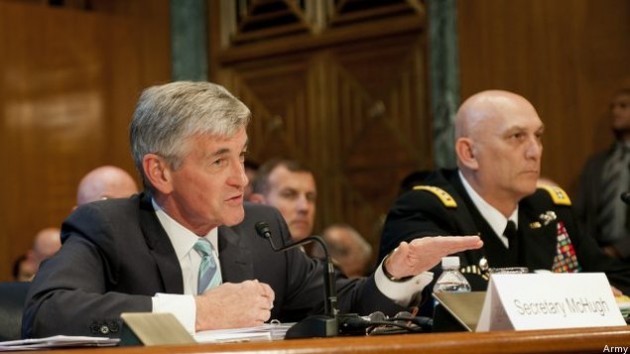490K Soldiers May Not Be Enough: Odierno
Posted on

Army Sec. John McHugh and Chief of Staff Gen. Ray Odierno.
AUSA: 490,000 Army soldiers may not be enough to cope with an increasingly unstable world. Two years ago — before the rise of the Islamic State, before Russia’s stealth invasion of Ukraine, before Ebola erupted in Africa — Army Chief of Staff Ray Odierno testified that an army of 490,000 active-duty troops, 350,000 Guard soldiers, and 205,000 reservists would suffice to execute President Obama’s strategy for the post-Afghan War world.
“Back in 2012, we testified to the size of the Army we thought needed — 490,000 [active-duty soldiers],” Odierno told reporters at the Association of the US Army conference today. “Because of sequestration, we came back and said, we’ve done some more work, we can probably do it at 450, but we have some concerns about that and the risk is increasing.”
“The problem is since we made those statements, the world is changing in front of us,” Odierno said. “We’ve seen Russian aggression in eastern Europe, we’ve seen ISIS, we’ve seen some increased instability in other places, so I have some concern whether even going below 490 is the right thing to do.”
However small the force gets, Odierno is increasingly concerned it won’t be ready to fight in a major crisis. Already Army units have separate and unequal training and equipment depending on their missions. “Based on the budget, tiered readiness is a reality, it’s a reality today,” he said. The question now, he said, “it’s how much tiered readiness are you going to have.”
“Beginning in ’16 we’re not going to be able to sustain the level of readiness [we need] if the commitments continue at the level they are now,” Odierno said. ” “I swore that I would never send soldiers into a place not properly prepared, trained, or equipped — and I’ll probably get away with that because I’ll leave at the end of this year, beginning of next year. But I worry for the next chief.”
Added Army Secretary John McHugh, “I don’t think there’s any question the vast, vast majority of members on both sides of the aisle, in both houses [of Congress], understand the challenges…. The challenge for members, as it always is, to try to take that baseline agreement that something needs to be done and develop a pathway by which you can pass it through the House and Senate and get it through a conference committee…. in these very politically complicated times.”
It’s not easy, said McHugh, “I get it. I was a 17-year member of the House Armed Services Committee.” But Congress has to act.
“As I go round individually, everyone understands and is worried about the impact of our budget,” said Odierno. “The problem we have is collectively we can’t get them right now to make a decision.”
Amidst all this uncertainty, I asked, how can the service roll out a new “Army Operating Concept,” as it is scheduled to do tomorrow, that purports to chart a path towards the force of 2025?
“You’ve got to start sometime. You can’t just say it’s too hard we’re going to delay it,” Odierno replied. “We have to begin now” to lay the foundations for the training, tactics, and equipments of 2025. “The intellectual must precede the physical,” he said, quoting AUSA president and former Army Chief of Staff Gen. Gordon Sullivan.
When you look at the Army Operating Concept, Sec. McHugh added, “you’ll note that a very significant portion of that is how do we develop future army leaders to operate in unpredictable environments…. It actually kind of underscores that our AOC has to go forward given the unpredictability of the moment.”
Subscribe to our newsletter
Promotions, new products and sales. Directly to your inbox.
